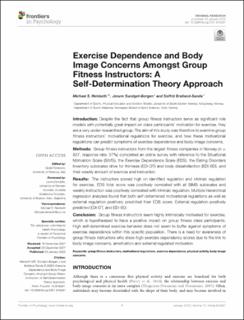| dc.contributor.author | Reinboth, Michael Sæther | |
| dc.contributor.author | Sundgot-Borgen, Jorunn | |
| dc.contributor.author | Bratland-Sanda, Solfrid | |
| dc.date.accessioned | 2022-06-30T12:33:15Z | |
| dc.date.available | 2022-06-30T12:33:15Z | |
| dc.date.created | 2022-01-21T12:51:38Z | |
| dc.date.issued | 2022 | |
| dc.identifier.citation | Frontiers in Psychology. 2022, 12, Artikkel 816287. | en_US |
| dc.identifier.issn | 1664-1078 | |
| dc.identifier.uri | https://hdl.handle.net/11250/3001789 | |
| dc.description | This is an open-access article distributed under the terms of the Creative Commons Attribution License (CC BY). The use, distribution or reproduction in other forums is permitted, provided the original author(s) and the copyright owner(s) are credited and that the original publication in this journal is cited, in accordance with accepted academic practice. No use, distribution or reproduction is permitted which does not comply with these terms. | en_US |
| dc.description.abstract | Introduction: Despite the fact that group fitness instructors serve as significant role models with potentially great impact on class participants' motivation for exercise, they are a very under-researched group. The aim of this study was therefore to examine group fitness instructors' motivational regulations for exercise, and how these motivational regulations can predict symptoms of exercise dependence and body image concerns.
Methods: Group fitness instructors from the largest fitness companies in Norway (n = 837, response rate: 57%) completed an online survey with reference to the Situational Motivation Scale (SIMS), the Exercise Dependence Scale (EDS), the Eating Disorders Inventory subscales drive for thinness (EDI-DT) and body dissatisfaction (EDI-BD), and their weekly amount of exercise and instruction.
Results: The instructors scored high on identified regulation and intrinsic regulation for exercise. EDS total score was positively correlated with all SIMS subscales and weekly instruction was positively correlated with Intrinsic regulation. Multiple hierarchical regression analyses found that both self-determined motivational regulations as well as external regulation positively predicted their EDS score. External regulation positively predicted EDI-DT, and EDI-BD.
Conclusion: Group fitness instructors seem highly intrinsically motivated for exercise, which is hypothesized to have a positive impact on group fitness class participants. High self-determined exercise behavior does not seem to buffer against symptoms of exercise dependence within this specific population. There is a need for awareness of group fitness instructors who show high exercise dependency scores due to the link to body image concerns, amotivation and external regulated motivation. | en_US |
| dc.language.iso | eng | en_US |
| dc.subject | body image concerns | en_US |
| dc.subject | exercise dependence | en_US |
| dc.subject | group fitness instructors | en_US |
| dc.subject | motivational regulations | en_US |
| dc.subject | physical activity | en_US |
| dc.title | Exercise dependence and body image concerns amongst group fitness instructors: A self-determination theory approach | en_US |
| dc.type | Peer reviewed | en_US |
| dc.type | Journal article | en_US |
| dc.description.version | publishedVersion | en_US |
| dc.rights.holder | © 2022 Reinboth, Sundgot-Borgen and Bratland-Sanda | en_US |
| dc.source.pagenumber | 8 | en_US |
| dc.source.volume | 12 | en_US |
| dc.source.journal | Frontiers in Psychology | en_US |
| dc.identifier.doi | 10.3389/fpsyg.2021.816287 | |
| dc.identifier.cristin | 1987369 | |
| dc.description.localcode | Institutt for idrettsmedisinske fag / Department of Sports Medicine | en_US |
| dc.source.articlenumber | 816287 | en_US |
| cristin.ispublished | true | |
| cristin.fulltext | original | |
| cristin.qualitycode | 1 | |
